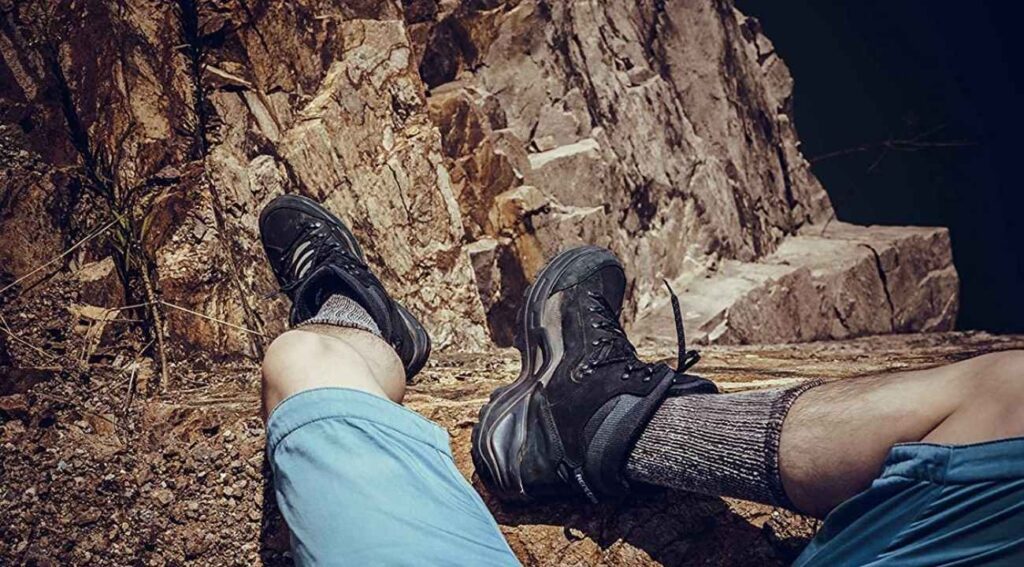As much as you don’t ignore your footwear for an enjoyable outdoor adventure like hiking, you shouldn’t forget to choose the right type of hiking socks. Because, on your hiking adventure, the last thing you want to worry about is your feet.
Our feet carry the load of our bodies and belongings, so if your feet aren’t happy, you’re probably not going to have an enjoyable time on your trip. Therefore, choosing a quality pair of hiking socks is important as the best pair will save you from blisters, hot spots, and even injuries. And it can make all the difference between a pleasing hiking adventure and an uncomfortable one.
But how do you choose them? And what are the things that you need to consider? Well, don’t worry, this article will help you choose a suitable pair of hiking socks for yourself.
Hiking Socks
Apart from hiking boots, a pair of hiking socks are the most important piece of equipment worn hiking. A quality pair will provide additional cushion to the front and the heel area of your feet.
Why Do You Need To Wear Them?
Well, unlike a pair of cotton socks that can also become stinky and hold moisture, a good pair of hiking socks won’t rub against the back of your foot. Thus, it’ll prevent injuries, and you can avoid getting blisters in case you take thousands of steps or hike for an extended period.
Cushioning, moisture-wicking properties, insulation, and compression – are the things that differentiate hiking socks from ordinary socks. And most importantly, a quality pair of hiking socks will provide excellent comfort and peace of mind. That’s why you need them.
Types Of Hiking Socks
There are many types of hiking socks available. They are- trainer socks, crew socks, liner socks, and double-layer walking socks.
- Trainer Socks: Trainer socks are great for short hikes in Summer or warmer environments and aren’t suitable for long hikes. You can wear them with your walking shoes if you want.
- Crew Socks: Crew socks are the most common ones. They are usually ribbed at the top portion. Besides, they are mid-calf in terms of length and thickness.
- Liner Socks: Liner socks will prevent blisters by wicking moistures that cause friction during a long hike. They are primarily designed for that. Besides, they are thin, and you can wear them under a thicker pair of socks.
- Double-Layer Walking Socks: These socks are very thick in nature. They are designed for added comfort. As they are thick, they’re great for winter use. And it’s better to avoid them during Summer.
How To Choose?
Now we’ve come to the point. How can you choose the right type of hiking socks from all the sock options available in the market? Well, let’s look at some points that you need to consider.

Sock Height
There are three major aspects. First of all, you need to consider sock height. Choosing the right height for your socks can protect you against abrasions and injuries. Take a look at your footwear before choosing the right height for your socks. For hiking boots, you need to wear socks that have a good height. Short socks are best suited if you use trail runners, sneakers, or other soft footwear.
- No-show Socks
No-show Socks are short ones with very little protection against your skin-to-footwear abrasions. So it’s appropriate with your trail running shoes, light hiking shoes, and even sandals.
- Ankle Socks
Ankle Socks stay a bit higher than no-show socks. This is because they usually cover your ankle bone with comparatively more protection.
- Crew Socks
The height of Crew Socks is considered the classic height for a hiking sock. Their height is usually a few inches above the ankles of your feet. Hence, they offer excellent protection against abrasions. You can wear them with low-cut boots or shoes.
- Knee-High socks
These are a better fit for mountaineering. Knee-high sock’s height coverage will keep your lower legs warm during the coldest of environments. They are really high socks meant to be worn with sturdy boots.
Cushioning
The second most important thing you need to consider is cushioning. It’s the thickness of the socks or the fluffiness they offer for your feet. Hiking socks usually add extra cushioning where it’s most needed. Less cushioning or no cushioning for hotter months makes sense, whereas heavy cushion socks are great for colder months.
Fabric Materials
The type of fabric used in hiking socks is also very crucial. The types are wool, Marino wool, soft material, and wool blended with some other fabric. Among them, wool is the most popular fabric for its temperature-regulating properties. Wool keeps your feet dry and warm. Besides, wool is breathable and antimicrobial.
Merino wool is also particularly popular for its softer fiber that can avoid the scratchiness of the wool. On the other hand, Polyester and Nylon are synthetic materials that will help because of their moisture-wicking and quick-drying properties. For a better fit, Spandex is a good option. The only thing you want to avoid is cotton. Because cotton holds moisture, it can cause blisters and discomfort in general.
Addition Tips
Besides, there are other key aspects to take into consideration. For instance:
- Size: Always go for the right size before plunking down your hard-earned money for a pair of hiking socks. If possible, make sure you go to an actual outdoor store where you can measure your feet and read the sizing chart before you make a purchase.
- Fit: Hiking socks are not medical-grade compression socks, but you need to look for a pair of socks that will be a snug fit for your feet. At the same time, avoid socks with a tight fit to fend off blisters.
- Moisture-Wicking Properties: Dry feet are happy feet. Your feet become stinky if they get wet. And that’s when your feet become prone to blisters. Avoid cotton socks. Plus, if you do a lot of water crossings, you can wear waterproof socks, but avoid using them in warmer months. In some cases, you can even use a sock liner for moisture-wicking.
- Thickness: For summer weather conditions, go for lightweight socks in nature. Remember, thick socks aren’t usually meant for warm environments. On the contrary, purchase mid-weight, heavyweight, or even trekking-style socks for winter use.
- Comfort: For optimum comfort, find something warmer. It’s not just about the brands, sometimes seemingly cheaper brands can also provide the necessary warmth.
- Durability: Cushioning and strong weave add to the strength apart from insulation. Therefore, hiking socks do last a long time even though you use them frequently. Brands like Costco and Wigwam make hiking socks that can stand up to a higher degree of abuse.
- Sustainability: Everyone seems to be focusing on sustainability in the outdoor industries these days. People who care for sustainable environments prefer socks that are made from recycled materials. Besides, there’s a certification called Responsible Wool Standard or R.W.S. The R.W.S.-certified wool is made in accordance with strict animal welfare and environmental standards.
If you can take proper care, you can probably enjoy years of hiking in your hiking socks. Just don’t put them in dryers. Air drying is the best way to keep the right fit and dry the socks. There are many hiking sock options available today.
But not all of them are durable, comfortable, and appropriate for use. Hiking socks from renowned brands like Smartwool, Wigwam, Darn Tough, Costco, Thorlos, REI, etcetera are pretty great as well. So, that’s how you can choose a Pair of Hiking Socks for your next hiking adventure.

William Arrovo seeks thrills and laughter in everything he comes across. He is a fun loving person with a zest of exploring the breathtaking places around the globe. He feels content in sharing his experiences of travelling to various countries. He is grateful about enriching himself with a myriad of cultures and rejuvenating his soul while staying outdoors.









Leave a Comment